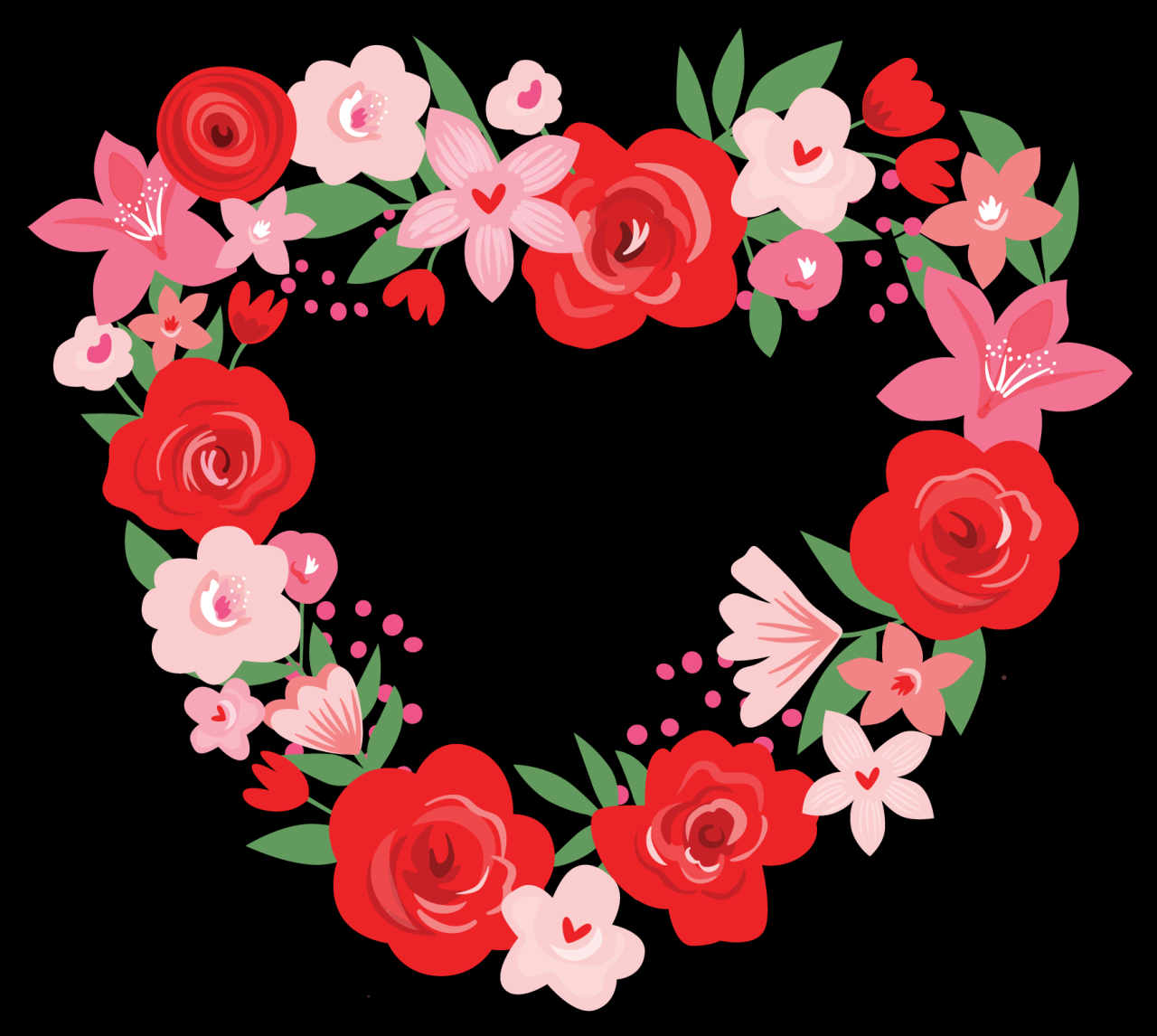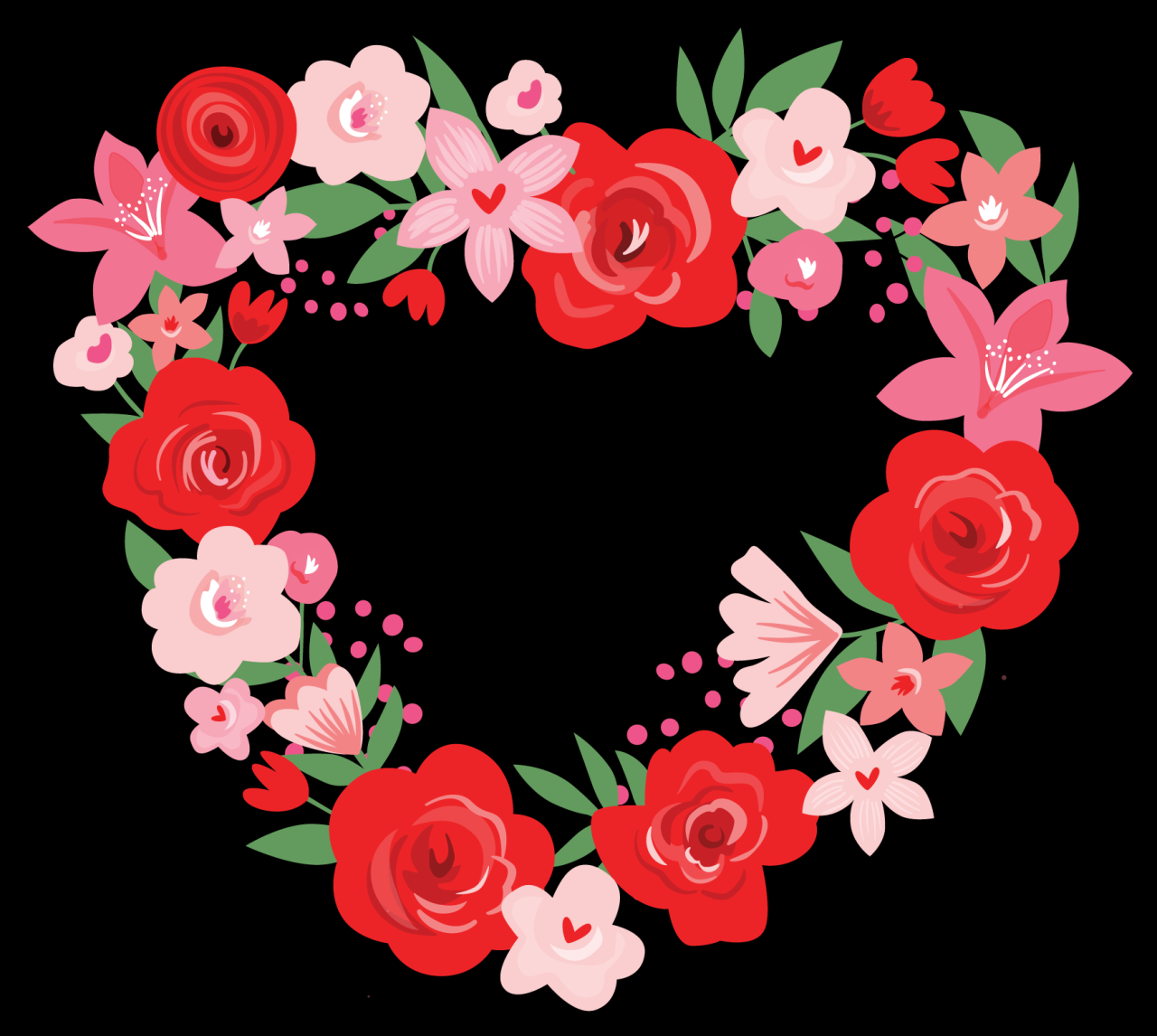The wreath of hearts, an enduring motif that has captivated cultures and inspired countless works of art, invites us on a journey through history, symbolism, and artistic expression. Its intricate design, imbued with profound meaning, has woven its way into our lives, gracing everything from ancient artifacts to modern-day fashion.
From its origins in ancient Greece to its enduring presence in contemporary culture, the wreath of hearts has evolved and adapted, reflecting the ever-changing human experience. Let us delve into its rich tapestry, exploring the stories and emotions it has carried throughout the ages.
Historical Significance of the Wreath of Hearts

The wreath of hearts is a decorative motif that has been used for centuries in various cultures around the world. It typically consists of a circle or oval shape made up of interlocking hearts, often with additional embellishments such as flowers, leaves, or ribbons.
The origins of the wreath of hearts can be traced back to ancient Greece, where it was used as a symbol of love, marriage, and fertility. In the Middle Ages, the wreath of hearts became a popular motif in Christian art, where it was often used to represent the crown of thorns worn by Jesus Christ.
During the Renaissance, the wreath of hearts was adopted by secular artists and craftsmen, who used it to decorate a wide range of objects, from jewelry to furniture.
Examples of Historical Artifacts and Artworks
- A gold wreath of hearts from the 4th century BC, discovered in a tomb in Greece.
- A mosaic depicting a wreath of hearts from the 6th century AD, found in the Hagia Sophia in Istanbul.
- A painting by Sandro Botticelli from the 15th century AD, which features a wreath of hearts surrounding the Virgin Mary and the infant Jesus.
- A tapestry from the 16th century AD, which depicts a wreath of hearts surrounding a portrait of Queen Elizabeth I.
Symbolism and Meaning
The wreath of hearts holds profound symbolic significance, evoking myriad interpretations that delve into the depths of human emotions and connections.
At its core, the wreath represents the universal language of love, transcending boundaries and uniting hearts across time and distance. Its circular form signifies the eternal nature of love, its ability to endure and grow with each passing moment.
Love and Unity
The intertwining hearts within the wreath symbolize the merging of souls, the unbreakable bond between two individuals who have found solace and completion in each other’s embrace. It represents the unity that transcends physical proximity, creating an unyielding connection that defies time and space.
The wreath of hearts also embodies the collective spirit of love, reminding us that we are all interconnected and have the capacity to spread love and compassion throughout the world. By sharing this symbol, we celebrate the power of human connection and the transformative nature of love.
Remembrance and Tribute
In many cultures, the wreath of hearts is used as a symbol of remembrance and tribute. It is often placed on graves or memorials to honor the memory of loved ones who have passed away. The wreath serves as a tangible reminder of the love and connection that continue to exist beyond the physical realm.
The wreath of hearts also represents the enduring legacy of those who have made significant contributions to society. It is a symbol of gratitude and appreciation for their lives and work, ensuring that their memory and impact will be remembered for generations to come.
Artistic Applications
The wreath of hearts has found its way into various art forms, transcending time and cultures. It has been a beloved motif in painting, sculpture, jewelry, and textiles, each medium adding its own unique interpretation to this enduring symbol.
Painting
In paintings, the wreath of hearts often represents love, devotion, and affection. It may adorn the heads of angels, saints, or lovers, symbolizing their pure and unwavering love. In portraits, a wreath of hearts surrounding the subject’s head conveys a sense of adoration and respect.
Sculpture
Sculptures featuring wreaths of hearts are often found in churches, gardens, and public spaces. They serve as poignant reminders of the power of love and its ability to conquer all. The intricate carvings and delicate details of these sculptures bring the symbol to life, creating a tangible representation of love’s eternal nature.
Jewelry
Jewelry adorned with wreaths of hearts has been popular for centuries. Necklaces, bracelets, and earrings featuring this motif symbolize love, commitment, and friendship. The intricate metalwork and sparkling gemstones add an element of elegance and sophistication to these wearable works of art.
Textiles
Textiles incorporating wreaths of hearts bring a touch of romance and warmth to any space. Embroidered or woven into fabrics, these wreaths adorn curtains, tablecloths, and cushions, creating a cozy and inviting atmosphere. The soft textures and vibrant colors of these textiles make them a delightful addition to any home.
Design Elements: Wreath Of Hearts
Wreaths of hearts showcase a distinct design aesthetic, characterized by intricate arrangements of hearts, carefully crafted to convey emotions and symbolism.
The shape of the wreath is typically circular or oval, creating a harmonious and balanced composition. The hearts are arranged within this framework, often overlapping and intertwining, forming a cohesive and visually appealing design.
Shape
The circular shape of the wreath represents unity, eternity, and the cyclical nature of love. The hearts, arranged within this shape, symbolize the interconnectedness and enduring nature of relationships.
Color
The color palette used in wreath of hearts designs often consists of warm and vibrant hues, such as red, pink, and purple. These colors evoke emotions of love, passion, and affection, enhancing the symbolic meaning of the design.
Composition
The composition of the wreath is carefully considered, with each heart placed intentionally to create a harmonious and visually appealing design. The hearts may be arranged symmetrically or asymmetrically, depending on the desired effect. The overall composition conveys a sense of balance and unity, reinforcing the symbolic meaning of love and connection.
Cultural Variations
The wreath of hearts, a timeless symbol of love and affection, has transcended cultural boundaries, acquiring diverse interpretations and significance across regions and time periods. Its multifaceted nature reflects the richness of human emotion and the universal language of love.
Ancient Greece and Rome
In ancient Greece, the wreath of hearts represented the goddess Aphrodite, the embodiment of beauty, love, and desire. The symbol adorned temples and altars, symbolizing the sacred nature of love and its divine origins. Similarly, in ancient Rome, the wreath of hearts was associated with the goddess Venus, the Roman counterpart of Aphrodite, and symbolized the power and allure of love.
Medieval Europe
During the Middle Ages in Europe, the wreath of hearts became a popular motif in courtly love and chivalry. Knights and ladies exchanged wreaths as tokens of their affection, and the symbol adorned tapestries, paintings, and other works of art, representing the idealized and romantic nature of love.
Renaissance Italy
In Renaissance Italy, the wreath of hearts evolved into a symbol of betrothal and marriage. The exchange of wreaths between lovers represented their commitment to each other and their future union. This interpretation of the wreath of hearts persists in many cultures today, where it remains a symbol of love and the promise of a shared future.
Contemporary Interpretations
In contemporary times, the wreath of hearts continues to be a versatile symbol, embracing both traditional and modern interpretations. It is used in jewelry, fashion, and home decor, representing love, friendship, and unity. The symbol has also been adopted by various social movements, representing inclusivity, diversity, and the interconnectedness of all people.
Contemporary Uses
The wreath of hearts motif has transcended its traditional origins, finding modern applications in various realms of contemporary life. From fashion to home décor and popular culture, the enduring appeal of this timeless symbol continues to inspire.
In the fashion world, the wreath of hearts has become a beloved embellishment, adorning everything from delicate jewelry to bold statement pieces. Necklaces, earrings, and bracelets featuring intertwined hearts add a touch of romance and charm to any outfit.
Home Décor
Within the realm of home décor, the wreath of hearts motif brings warmth and affection to living spaces. Decorative pillows, throws, and wall art featuring this symbol create a cozy and inviting atmosphere. Floral arrangements and table centerpieces adorned with heart-shaped wreaths add a touch of whimsy and elegance to any room.
Popular Culture
In popular culture, the wreath of hearts has become synonymous with love and romance. Greeting cards, gift wrapping, and other festive items often incorporate this motif to convey heartfelt messages and emotions. The wreath of hearts has also found its way into literature, film, and music, serving as a poignant symbol of love, connection, and the enduring human spirit.
Design a Wreath of Hearts
Creating a wreath of hearts is a simple yet heartfelt project that can add a touch of love and warmth to your home. Whether you’re making one for yourself or as a gift, the process is both enjoyable and rewarding.
Here’s a step-by-step guide to help you create a beautiful wreath of hearts:
Materials, Wreath of hearts
- Wire wreath form
- Red, pink, or white felt
- Scissors
- Glue gun
- Embellishments (optional)
Instructions
- Draw a heart shape on the felt and cut it out. Repeat to create multiple hearts in various sizes and colors.
- Apply a small amount of glue to the back of each heart and attach it to the wire wreath form.
- Continue gluing hearts to the wreath form, overlapping them slightly to create a full and lush look.
- Once the wreath is covered in hearts, add any desired embellishments, such as beads, sequins, or ribbon.
- Hang your wreath of hearts on a door, wall, or window to add a touch of love and cheer to your space.
Tips
- Choose colors and patterns that complement your home décor or the occasion for which you’re making the wreath.
- Use a variety of heart sizes and shapes to create a more dynamic look.
- Add embellishments sparingly to avoid overwhelming the wreath.
- If you’re using a glue gun, be sure to test it on a scrap piece of felt first to ensure the glue doesn’t damage the material.
Create a Table of Heart Wreaths
Organize a table showcasing different types of heart wreaths. Include columns for image, description, materials, and price.
Image, Description, Materials, and Price
| Image | Description | Materials | Price |
|---|---|---|---|
| [Image of a heart wreath made of red felt] | A heart wreath made of red felt, decorated with white lace and a red bow. | Felt, lace, ribbon | $20 |
| [Image of a heart wreath made of pink flowers] | A heart wreath made of pink flowers, decorated with green leaves and a white ribbon. | Flowers, leaves, ribbon | $30 |
| [Image of a heart wreath made of burlap] | A heart wreath made of burlap, decorated with a white lace heart and a red bow. | Burlap, lace, ribbon | $25 |
| [Image of a heart wreath made of wood] | A heart wreath made of wood, decorated with a white heart and a red bow. | Wood, paint, ribbon | $35 |
| [Image of a heart wreath made of metal] | A heart wreath made of metal, decorated with a white heart and a red bow. | Metal, paint, ribbon | $40 |
Mood Board

Immerse yourself in the realm of heart wreaths, where love, affection, and warmth intertwine. Our visual mood board paints a vivid tapestry of emotions, evoking the very essence of this timeless motif.
Soft, ethereal hues of pink, blush, and ivory dance upon the canvas, creating a sense of tenderness and tranquility. The gentle touch of lace, ribbons, and delicate fabrics adds a touch of femininity and elegance, capturing the intricate beauty of the human heart.
Nature’s Embrace
- Floral accents bloom with vibrant colors, symbolizing the joy and abundance of life.
- Twigs and branches intertwine, forming organic shapes that represent growth and resilience.
- Leaves of emerald green whisper tales of hope and renewal, adding a touch of nature’s tranquility.
Closing Summary
The wreath of hearts, a timeless symbol of love, unity, and remembrance, continues to enchant and inspire. Its enduring appeal lies in its ability to transcend cultural boundaries and resonate with the human heart. As we bid farewell to this exploration, let us carry the wreath of hearts with us, embracing its message of love and connection in all its forms.
Frequently Asked Questions
What is the historical significance of the wreath of hearts?
The wreath of hearts motif has its roots in ancient Greece, where it symbolized love, fertility, and the union of two souls.
What does the wreath of hearts represent?
The wreath of hearts is a multifaceted symbol that represents love, unity, remembrance, and the interconnectedness of all things.
How has the wreath of hearts been used in art?
The wreath of hearts has been incorporated into various art forms, including painting, sculpture, jewelry, and textiles, serving as a decorative element and a symbol of love and devotion.

